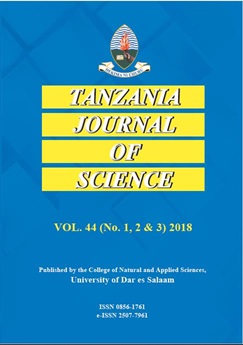Plant Diet Selectivity and Some Environmental Parameters at Foraging Sites of Wattled Crane (Bugeranus carunculatus) in Malagarasi Wetlands, Tanzania
Abstract
Wattled Crane Bugeranus carunculatus is a threatened wetland-dependent bird species of sub-Saharan Africa with a declining population throughout its range due to habitat degradation. Ecological studies on this species have come from large populations in Botswana and Zambia. Little is known of the isolated small populations, especially those in Tanzania where about 200 individuals survive. This study reports observations made on vegetation height, water depth and consumption of plant tubers at foraging locations of the Wattled Crane in Malagarasi-Muyovozi Ramsar Site. Foraging birds preferred wet habitats with short vegetation. Birds fed mainly on Pycreus nitidus and Cyperus articulatus plant tubers but not those of Eleocharis, a chief food plant in southern Africa, which in this study was restricted to deep water levels along lakeshores. As water gradually recedes, the swamp provides good foraging environment for the Wattled Crane. Moreover, it is during the same period when human activities especially livestock grazing and burning increase in the swamp. These human activities are likely to interfere with water level balance and change wetland vegetation structure. Furthermore, if such activities are not controlled could affect productivity, availability and accessibility of the plant tubers, the predominant food of the globally threatened Wattled Crane
Keywords: Eleocharis; Pycreus nitidus; tuber selectivity; wetland-dependent birds


